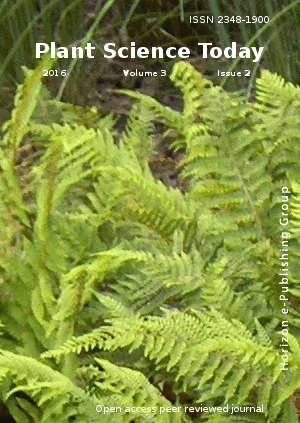Detection of simple sequence repeats in the chloroplast genome of Tetraphis pellucida Hedw.
DOI:
https://doi.org/10.14719/pst.2016.3.2.206Keywords:
Bryophytes, chloroplast genome, microsatellites, moss, TetraphisAbstract
Simple sequence repeats (SSRs) consist of short repeat motifs of 1-6 nucleotides and are found in DNA sequences.The present study was conducted to detect SSRs in chloroplast genome of Tetraphis pellucida (Accession number: NC_024291), downloaded from the National Center for Biotechnology Information (NCBI). The sequence was mined with the help of MISA, a Perl script, to detect SSRs. The length of SSRs defined as ?12 for mono, di, tri and tetranucleotide, ?15 for pentanucleotide and ?18 for hexanucleotide repeats. In total, 41 perfect microsatellites were identified in 127.489 kb sequence mined. An average length of 13.56 bp was calculated for mined SSRs with a density of 1 SSR/3.04 kb. Depending on the repeat units, the length of SSRs ranged from 12 to 20 nt. Dinucleotides (14, 34.15%) were the most frequent repeat type, followed by tetranucleotides (10, 24.39%), trinucleotides (7, 17.07%), mononucleotides (6, 14.63%) and pentanucleotide (4, 9.76%) repeats. Hexanucleotide repeats were completely absent in chloroplast genome of Tetraphis pellucida. The mined SSRs can be used to develop molecular markers and genetic diversity studies in Tetraphis species.Downloads
References
Bell N. E., J. L. Boore, B. D. Mishler, and Hyvonen J. 2014. Organellar genomes of the four-toothed moss, Tetraphis pellucida. BMC Genomics 15: 383. doi: 10.1186/1471-2164-15-383
Kapil A., P. K. Rai and A. Shanker. 2014. ChloroSSRdb: a repository of perfect and imperfect chloroplastic simple sequence repeats (cpSSRs) of green plants. Database (Oxford) 2014 doi: 10.1093/database/bau107.
Kumar M., A. Kapil and A. Shanker. 2014. MitoSatPlant: mitochondrial microsatellites database of viridi plantae. Mitochondrion 19: 334-337. doi: 10.1016/j.mito.2014.02.002
Rajendrakumar P., A. K. Biswal, S. M. Balachandran Srinivasarao K, and R. M. Sundaram. 2007. Simple sequence repeats in organellar genomes of rice: frequency and distribution in genic and intergenic regions. Bioinformatics 23: 1-4.
Pandey S., V. Sharma and A. Alam. 2016. Potential of microsatellites markers for the genetic analysis of bryophytes. Not Sci Biol 8(1): 37-46. doi: 10.15835/nsb.8.1.9748
Shanker A. 2012. Chloroplast genomes of bryophytes: A review. Arch Bryol 143: 1-5.
Shanker A. 2013a. Paraphyly of bryophytes inferred using chloroplast sequences. Arch Bryol 163: 1-5.
Shanker A. 2013b. Inference of bryophytes paraphyly using mitochondrial genomes. Arch Bryol 165: 1-5.
Shanker A. 2013c. Combined data from chloroplast and mitochondrial genome sequences showed paraphyly of bryophytes. Arch Bryol 171: 1-9.
Shanker A. 2013d. Identification of microsatellites in chloroplast genome of Anthoceros formosae. Arch Bryol 191: 1-6.
Shanker A. 2013e. Mining of simple sequence repeats in chloroplast genome of a parasitic liverwort: Aneura mirabilis. Arch Bryol 196: 1-4.
Shanker A. 2014a. Computational mining of microsatellites in the chloroplast genome of Ptilidium pulcherrimum, a liverwort. Intl Jour Environ 3: 50-58. doi: 10.3126/ije.v3i3.11063
Shanker A. 2014b. Computationally mined microsatellites in chloroplast genome of Pellia endiviifolia. Arch Bryol 199: 1-5.
Shanker A. 2014c. Simple sequence repeats mining using computational approach in chloroplast genome of Marchantia polymorpha. Arctoa 23, 145-149.
Shanker A. 2015. An update on sequenced chloroplast genomes of Bryophytes. Plant Sci Today 2, 102-104. doi: 10.14719/pst.2015.2.4.143
Shanker A., A. Bhargava, R. Bajpai, S. Singh, S. Srivastava, and V. Sharma. 2007a. Bioinformatically mined simple sequence repeats in UniGene of Citrus sinensis. Sci Hort 113, 353-361. doi: 10.1016/j.scienta.2007.04.011
Shanker A., A.Singh and V. Sharma. 2007. In silico mining in expressed sequences of Neurospora crassa for identification and abundance of microsatellites. Microbiol Res 162, 250- 256.
Srivastava D. and A. Shanker. 2015a. In silico mining and analysis of simple sequence repeats inchloroplast genomes of order Rosales. Res Jour Bioinformatics 2: 1-9.
Srivastava D. and A. Shanker. 2015b. Identification of simple sequence repeats in chloroplast genomes of Magnoliids through bioinformatics approach. Interdiscip Sci Comput Life Sci. doi 10.1007/s12539-015-0129-4.
Varshney R. K., T. Thiel, N. Stein, P. Langridge and A. Graner. 2002. In silico analysis on frequency and distribution of microsatellites in ESTs of some cereal species. Cell & Mol Biol Lett 7: 537-546.
Downloads
Published
How to Cite
Issue
Section
License
Copyright and Licence details of published articles
Authors who publish with this journal agree to the following terms:
- Authors retain copyright and grant the journal right of first publication with the work simultaneously licensed under a Creative Commons Attribution License that allows others to share the work with an acknowledgement of the work's authorship and initial publication in this journal.
- Authors are able to enter into separate, additional contractual arrangements for the non-exclusive distribution of the journal's published version of the work (e.g., post it to an institutional repository or publish it in a book), with an acknowledgement of its initial publication in this journal.
Open Access Policy
Plant Science Today is an open access journal. There is no registration required to read any article. All published articles are distributed under the terms of the Creative Commons Attribution License (CC Attribution 4.0), which permits unrestricted use, distribution, and reproduction in any medium, provided the original author and source are credited (https://creativecommons.org/licenses/by/4.0/). Authors are permitted and encouraged to post their work online (e.g., in institutional repositories or on their website) prior to and during the submission process, as it can lead to productive exchanges, as well as earlier and greater citation of published work (See The Effect of Open Access).









